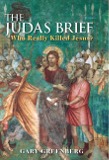I was thumb-wrestling with the Gospel of Judas for much of the day and it occurred to me that this Gospel seems to take the Gospel of Mark as a primary source of information. The most telling clue seems to be the treatment of the Twelve Disciples, but there are others.
The primary theme of Mark's Gospel appears to be that while Jesus was alive, no human truly knew the nature of Jesus, that the true identity of Jesus was only made clear in his death. This is contrary to the other canonical Gospels. For Mark, Jesus is the "Son of God, so-declared in the very first verse of his Gospel, but no human knows that this is the case. Even the disciples remain ignorant of who Jesus really is. The closest any human comes is when Peter identifies Jesus as the messiah, but even this identification turns out to be wrong, because Peter sees the messiah as a human figure and Jesus chastises him for that understanding.
"Get behind me, Satan! For you are setting your mind not on divine things but on human things." (Mark 8:30.)
In the Gospel of Judas, again, no human knows who Jesus really is and here, too, the disciples are again singled out for their ignorance.
"How do you know me? Truly [I] say to you no generation of the people that are among you will know me." (Line 16.)
And in contrast to Peter, who flunked Jesus' pop quiz on identification, in the Gospel of Judas only Judas gets the answer right, by saying that Jesus comes from a different non-earthly realm (referred to in this Gospel as "the immortal realm of Barbelo," a Gnostic term for one of the higher plains of existence.) This builds up directly from Mark's charge that Peter thinks of Jesus only in earthly terms.
Another parallel suggesting that Mark served as a source work is the placement of this particular incident in the Gospel of Judas. The conversation between Jesus and the disciples about the identity of Jesus follows in the wake of a discussion about a ritual involving bread, in which Jesus says that the disciples don't understand the true meaning of the ceremony and that they are making an improper sacrifice. In the Gospel of Mark, the story about the disciples being unaware of Jesus' true nature also follows in the wake of the disciples misunderstanding a bread metaphor. In Mark, the disciples had only a single loaf of bread and complained, and Jesus criticized them for not comprehending the meaning of the earlier incident involving the multiplication of the loaves of bread. With just a short diversion in which Jesus heals a blind man, Mark's story moves from the chastisement about the bread to the question of Jesus' identity, the same pattern as in the Gospel of Judas.
A particularly interesting clue concerns the treatment of Judas when he goes to the priests. Mark mysteriously fails to explain what motivated Judas to go to the priests, leaving open the opportunity for an explanation. Also in Mark, Judas does not ask for any money and only after the fact do the priests offer him payment. (Mark 14:10-11.) In Matthew Judas bargains for money and in Luke and John, Satan induces Judas to act, although John adds the motive of greed to the indictment. In the Gospel of Judas, however, the author seizes on the lack of explanation in Mark and has Jesus request that Judas go to the priests. Then after Judas goes through a spiritual elevation in the presence of Jesus, he suddenly finds himself in front of the priests, and, as in Mark, is offered money only after the fact.
Here is another important clue. In the shorter version of Mark, ending at 16:8, which most scholars believe is where the Gospel originally ended, there is an empty tomb but no actual post-crucifixion appearance of Jesus in human form. This plays into the Gnostic vision, which saw Jesus escaping his human body and ascending to the higher realm. In the Gospel of Judas the story also ends in sudden fashion, immediately after the priests handed Judas the money. There is no post-crucifixion appearance of a human Jesus, an ending consistent with the shorter version of Mark.
Finally, I would note one additional matter, which by itself wouldn't mean much, but in concert with the above evidence, further suggests that the author of the Gospel of Judas used the Gospel of Mark as a source. Mark introduces the parable of the sower (4:1-20), which is followed by Matthew and Luke. In this parable, Jesus teaches that you can't raise plants on a rocky base. In the Gospel of Judas Jesus teaches "It is impossible to sow seed on [rock] and harvest its fruit.



No comments:
Post a Comment